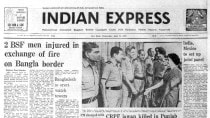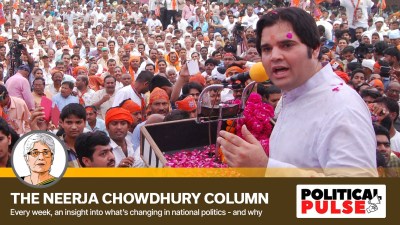- India
- International
Making of the ransom state
The kidnapping of Warren Weinstein, later killed by a US drone, is part of a spreading pattern in Pakistan.
 Weinstein was kidnapped three months after the US Navy SEALs raided a compound in Abbottabad and killed Osama bin Laden.
Weinstein was kidnapped three months after the US Navy SEALs raided a compound in Abbottabad and killed Osama bin Laden.On April 22, US President Barack Obama said he was sorry that a drone had inadvertently killed two hostages in January 2015, one Italian and the other an American citizen, while targeting an al-Qaeda leader in the tribal areas of Pakistan. He pledged to compensate the bereaved families. Seventy-year-old American Warren Weinstein was a well-publicised victim picked up in Lahore in 2011, while Giovanni Lo Porto was abducted from Multan. Both were aid workers. Obama should also compensate Weinstein’s family for the $2,50,000 they paid as ransom to al-Qaeda through a Pakistani “third party” who failed to deliver.
Warren Weinstein, from Rockville, Maryland, was a tenured political science professor at the State University of New York at Oswego in the 1970s. After he left teaching,Weinstein joined the US Agency for International Development (USAID) and went on to become the Pakistan country director for J.E. Austin Associates, a development contractor for the US government.
After Weinstein’s capture in July 2011, two cars and a motorbike were used to kidnap the son of former Punjab governor Salmaan Taseer — who had been killed earlier — from Lahore’s Gulberg area, in August, while he was on his way to office. The city was gripped with panic because this was a high-profile kidnapping. In February 2011, Lahore had seen the son-in-law of the former chairman of the joint chiefs of staff committee (CJCSC), General Tariq Majid, picked up by the same kidnappers. (He was somehow released after a possible ransom payment.) Lo Porto, doing a post-floods potable-water project in Multan, was picked up too, but it was hardly noticed by the media.
Majid’s son-in-law, Amir Malik, was a prosperous businessman. He was picked up by the Lashkar-e-Jhangvi (LeJ), an ally whose name appears on the al-Qaeda flag together with those of Jandullah and the Taliban. The terrorist outfit most certainly wanted — through Malik — to communicate with the Pakistan army. After the release from prison of the LeJ chief, Malik Ishaq, in May 2012, the ground may have been prepared for the denouement of the kidnap drama.
Weinstein was actually kidnapped three months after the US Navy SEALs raided a compound in Abbottabad and killed al-Qaeda chief Osama bin Laden. The then army chief, General Ashfaq Kayani, was in a foul mood and had begun a manhunt for “American agents” said to be going around destroying Pakistan’s internal security in the guise of “Blackwater” killers. Punjab’s then law minister, Rana Sanaullah, had the most unbuttoned mouth in the province and invited a barrage of denunciation from the opposition Pakistan Peoples Party, obfuscating the issue through mutual recrimination. Rana Sahib had put his foot in his mouth by hazarding a guess about who could have abducted the American from Lahore’s Model Town. He came on TV and opined that Warren Weinstein could have been doing “the kind of things in Pakistan that CIA contractor Raymond Davis had done, killing three people on a Lahore road”. No logic can unravel why he said that, unless he was pleased that a CIA agent was kidnapped by “friendly” terrorists.

Then an economist writing in The Express Tribune (August 26, 2011) clarified the status of the American: “Dr Warren Weinstein, who headed the Pakistan Initiative for Strategic Development and Competitiveness (Pisdac) project, is a very well-known figure within Pakistan’s aid and development community. Under the Pisdac project, Weinstein oversaw strategic interventions in the dairy, gems jewellery, marble and granite sectors in Pakistan, resulting in the establishment of companies such as Pakistan Stone Development Company and the Pakistan Dairy Development Company”.
Al-Qaeda finally announced its conditions. Ayman al-Zawahiri put out a video saying Weinstein would be released if “the US stopped drone strikes in Afghanistan, Pakistan, Yemen and Somalia and freed prisoners being held at Guantanamo Bay”. As a result of Kayani’s tolerance of al-Qaeda-linked terrorists, Pakistan kept a line of communication open and Weinstein’s family used Islamabad to keep him supplied with the heart pills he needed to survive.
Pakistan was the recipient of an American grant for being helpful in fighting terrorism; but it was actually fighting a covert war against America at home. Gallup polls showed that over 80 per cent Pakistanis hated America. And al-Qaeda and its minions exploited the situation, additionally demanding the release of an al-Qaeda agent, Aafiya Siddiqui, doing an 83-year sentence in the US. So popular is Siddiqui in Pakistan that political parties vie with one another to be her advocates. Al-Qaeda watches, smiling quizzically.
Amir Mir, writing in The News (April 27, 2015), revealed that Weinstein was kidnapped in 2011 and “sold” to al-Qaeda in North Waziristan by two LeJ members — Uzbek brothers Mohammad Ali Uzbek and Naimatullah Uzbek — who belonged to the Islamic Movement of Uzbekistan (IMU), now affiliated to Daesh, or the Islamic State (IS). Both were caught by “Pakistani authorities”, who believe them to be related to Tahir Yuldashev, the former IMU leader, killed in a CIA drone strike in the Pakistani tribal regions in 2009. The Uzbeks apparently first took the $2,50,000 from the Weinsteins, then sold the victim to an even better resourced al-Qaeda for a bigger sum.
The Uzbeks, now under arrest, carried genuine Pakistani passports and national identification cards. They had demanded
the release of 25 militants (all Pakistanis, except for eight Afghans) and Rs 4 billion as ransom for the release of Ali Haider Gilani, the son of former prime minister Yousaf Raza Gillani. They added to their demands the release of Mumtaz Qadri — now on death row for killing Salmaan Taseer — plus a billion rupees for Taseer’s son. Last month, Haider Gillani talked to his father on the phone from an unknown location saying all was well with him.
Pakistan is an oddity in the Islamic world. This is the only Muslim country where the media is free and where journalists get killed straying into grey areas where the state interfaces with terror. The Muslim mind in Pakistan, as elsewhere, is “bicameral”. There is a part that believes in conspiracies and communicates in Urdu; there is another that is rational and uses English, which doesn’t lend itself to conspiracy-weaving. The self-loathing seen daily in the media is owed to this partitioning of the national mind.
Ideology is coercive and usually produces a uniformity of mind, as was evidenced in the Soviet Union. Among Muslims, it produces the power to disagree with professional seniors on the basis of the “certitude” of ideology. The Soviet man obeyed. The Muslim believer may disobey on the basis of the difference of stringency of faith. A Sunni soldier or officer may disobey after sensing “superior” ideology in al-Qaeda, the Taliban and the IS, simply because they are more hardline. While all ideologies have been coercive, they have also tended to lose their intensity over time. But the faith of Islam becomes more hardline with time. Pakistan, from Jinnah to Zia, appears to prove it.
The writer is consulting editor, ‘Newsweek Pakistan’.
EXPRESS OPINION
Apr 25: Latest News
- 01
- 02
- 03
- 04
- 05










































